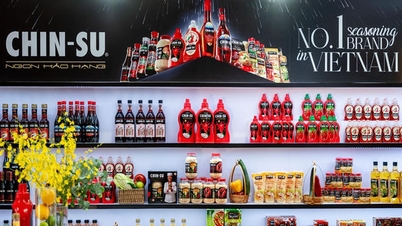In an episode of the satirical comedy series Portlandia , the characters are forced to share a long table with strangers, creating a series of awkward situations and awkward dialogue. The scene was once seen as a perfect illustration of the awkwardness many diners felt towards the “community dining” model - a controversial trend that became prominent in the 2010s.
But surprisingly, the long tables that once made many people “fear society” are making a strong comeback. And this time, the driving force does not come from the millennials - the group that started the trend - but from Gen Z, those born between 1997 and 2012.
New data from the reservation platform Resy reveals a stark generational divide: 90% of Gen Z diners say they prefer communal dining, compared to just 60% of Baby Boomers. That gap reflects not only contrasting social habits, but also hints at deeper shifts in food consumption behavior.
The return of the “communal dining table” is therefore not simply a repeat of a once-popular trend. This is a new signal that restaurants can exploit an emerging social need – the need to connect, experience and share space – opening up attractive business opportunities for the F&B industry.

Gen Z is bringing back the communal table trend, a once controversial communal dining model (Photo: FOODbible)..
“Medicine” for a lonely generation in the digital age
To understand why Gen Z is so eager to “rub elbows with strangers,” it’s important to look at the great paradox of this generation: they are the most connected group online, but also the most lonely. A Forbes statistic shows that 73% of Gen Z admit to feeling isolated on a regular basis. Having grown up in a pandemic, entering a digital workplace and communicating through screens, they crave real-life interactions – something no app can replace.
In that context, the communal dining table model becomes an effective “medicine”. It is not only a place to eat and drink, but also a space for “pressure-reducing” communication. Michael Della Penna - Strategy Director of InMarket - calls this a “social buffer zone”, especially suitable for young people who are anxious and lack confidence in direct communication.
“You don’t have to be the one to initiate a conversation or command attention,” he says. “You can engage in a more natural, relaxed way. It’s a gentle transition that allows Gen Z to connect without the pressure of leading the conversation.”
Resy's survey also showed clear results: 63% of participants said that shared tables were a great way to meet new people; a third said they had successfully made friends, and remarkably, 1 in 7 found a date from the experience.
In other words, Gen Z is turning mealtimes – a seemingly daily activity – into an opportunity to combat the “loneliness epidemic” that has engulfed their generation. This is not just a culinary trend, but also a social response of a generation seeking real connection in a world full of virtual connections.
Attractive business problem for F&B industry
From a business perspective, the return of the communal dining model is not just a detail of the culinary experience. It is becoming an important strategy for restaurants to attract and retain the young customer group that is reshaping the F&B market.
First, communal dining creates a natural marketing experience. For Gen Z, the value of a meal is not just about the food, but also the setting and the emotions that accompany it. “They grew up online but actively seek real connection. Restaurants are returning to that role as meeting spaces,” said Ashley Mitchell, Vice President of Marketing at East Coast Wings + Grill. Long tables where people share food and stories become the ideal backdrop for photos and videos that go viral on social media – an effective and cost-effective form of advertising.
Second, this model promotes the trend of “sharing dishes” - a subtle way to increase revenue. Culinary entrepreneur Steve Wong (New York) said that young diners are increasingly open to trying multiple dishes at the same time. When sitting at the same table, ordering more dishes to share becomes more natural, helping to increase the average value of each bill, while also matching the smart consumer psychology of Gen Z: Experience more without exceeding the cost.
Third, communal dining tables help restaurants become a “third space” - a place to socialize and connect beyond family and work. This is an important factor in building long-term customer loyalty. Pablo Rivero, CEO of Resy, believes that “communal dining tables turn dinner into a bonding experience; you never know who you’re going to meet, and that’s what makes it so appealing.” Investing in spaces rich in community is therefore investing in future customer loyalty.

For restaurants and investors, Gen Z's acceptance of communal seating is a business strategy (Photo: Toast POS).
A trend with a solid historical foundation
The return of communal dining is not a sudden trend. According to 12-time James Beard Award-winning restaurateur Donnie Madia, communal dining models often boom after periods of social upheaval or disruption. “After 9/11 in New York, people wanted to be closer together,” he says. “The same thing happened after the 2008 financial crisis, when diners returned to restaurants for a sense of celebration and connection.”
The post-Covid-19 period also follows the same rule. After a long period of social distancing, the need to meet, share and be present together has become the strongest driving force behind the rise of the communal dining table model. This shows that this is not a short-lived trend, but reflects a deep psychological need, a cyclical nature of modern society.
Gen Z – the generation that is turning away from AI in some personal experiences and reviving flip phones – is leading the comeback, seeking experiences that are not downloadable, not governed by algorithms, and cannot be replicated by technology.
For F&B businesses, this is a valuable opportunity. Brands that know how to meet this “thirst for connection” – turning restaurants into a safe, fun and engaging “third space” – will have an advantage in attracting and retaining Gen Z customers.
Source: https://dantri.com.vn/kinh-doanh/ban-an-chung-khi-noi-co-don-cua-gen-z-thanh-mo-vang-cho-nganh-fb-20251118113740988.htm





![[Photo] Prime Minister Pham Minh Chinh and his wife meet the Vietnamese community in Algeria](https://vphoto.vietnam.vn/thumb/1200x675/vietnam/resource/IMAGE/2025/11/19/1763510299099_1763510015166-jpg.webp)
![[Photo] General Secretary To Lam receives Slovakian Deputy Prime Minister and Minister of Defense Robert Kalinak](https://vphoto.vietnam.vn/thumb/1200x675/vietnam/resource/IMAGE/2025/11/18/1763467091441_a1-bnd-8261-6981-jpg.webp)





































































































Comment (0)